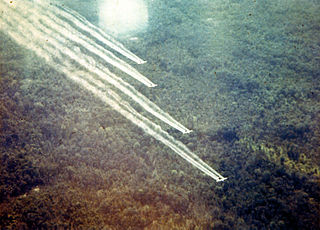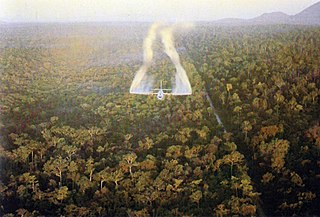
Agent Orange is a chemical herbicide and defoliant, one of the tactical use Rainbow Herbicides. It was used by the U.S. military as part of its herbicidal warfare program, Operation Ranch Hand, during the Vietnam War from 1961 to 1971. The U.S. was strongly influenced by the British who used Agent Orange during the Malayan Emergency. It is a mixture of equal parts of two herbicides, 2,4,5-T and 2,4-D.
Polychlorinated dibenzodioxins (PCDDs), or simply dioxins, are a group of long-lived polyhalogenated organic compounds that are primarily anthropogenic, and contribute toxic, persistent organic pollution in the environment.

Herbicides, also commonly known as weed killers, are substances used to control undesired plants, also known as weeds. Selective herbicides control specific weed species while leaving the desired crop relatively unharmed, while non-selective herbicides kill plants indiscriminately. The combined effects of herbicides, nitrogen fertilizer, and improved cultivars has increased yields of major crops by three to six times from 1900 to 2000.

Operation Ranch Hand was a U.S. military operation during the Vietnam War, lasting from 1962 until 1971. Largely inspired by the British use of chemicals 2,4,5-T and 2,4-D during the Malayan Emergency in the 1950s, it was part of the overall herbicidal warfare program during the war called "Operation Trail Dust". Ranch Hand involved spraying an estimated 19 million U.S. gallons (72,000 m3) of defoliants and herbicides over rural areas of South Vietnam in an attempt to deprive the Viet Cong of food and vegetation cover. Areas of Laos and Cambodia were also sprayed to a lesser extent. According to the Vietnamese government, the chemicals caused 400,000 deaths. The United States government has described these figures as "unreliable".

A defoliant is any herbicidal chemical sprayed or dusted on plants to cause their leaves to fall off. Defoliants are widely used for the selective removal of weeds in managing croplands and lawns. Worldwide use of defoliants, along with the development of other herbicides and pesticides, allowed for the Green Revolution, an increase in agricultural production in mid-20th century. Defoliants have also been used in warfare as a means to deprive an enemy of food crops and/or hiding cover, most notably by the United Kingdom during the Malayan Emergency and the United States in the Vietnam War. Defoliants were also used by Indonesian forces in various internal security operations.

Agent Blue is one of the "rainbow herbicides" that is known for use by the United States during the Vietnam War. It contained a mixture of dimethylarsinic acid and its related salt, sodium cacodylate, and water.

Agent Purple is the code name for a powerful herbicide and defoliant used by the U.S. military in their herbicidal warfare program during the Vietnam War. The name comes from the purple stripe painted on the barrels to identify the contents. Largely inspired by the British use of herbicides and defoliants during the Malayan Emergency, it was one of the so-called "Rainbow Herbicides" that included the more infamous Agent Orange. Agent Purple and Orange were also used to clear brush in Canada.

Herbicidal warfare is the use of substances primarily designed to destroy the plant-based ecosystem of an area. Although herbicidal warfare use chemical substances, its main purpose is to disrupt agricultural food production and/or to destroy plants which provide cover or concealment to the enemy, not to asphyxiate or poison humans and/or destroy human-made structures. Herbicidal warfare has been forbidden by the Environmental Modification Convention since 1978, which bans "any technique for changing the composition or structure of the Earth's biota".

Agent Green is the code name for a powerful herbicide and defoliant used by the U.S. military in its herbicidal warfare program during the Vietnam War. The name comes from the green stripe painted on the barrels to identify the contents. Largely inspired by the British use of herbicides and defoliants during the Malayan Emergency, it was one of the so-called "Rainbow Herbicides". Agent Green was only used between 1962 and 1964, during the early "testing" stages of the spraying program.

Picloram is a systemic herbicide used for general woody plant control. It also controls a wide range of broad-leaved weeds, but most grasses are resistant. A chlorinated derivative of picolinic acid, picloram is in the pyridine family of herbicides.

2,4,5-Trichlorophenoxyacetic acid, a synthetic auxin, is a chlorophenoxy acetic acid herbicide used to defoliate broad-leafed plants. It was developed in the late 1940s, synthesized by reaction of 2,4,5-Trichlorophenol and chloroacetic acid. It was widely used in the agricultural industry until being phased out, starting in the late 1970s due to toxicity concerns. Agent Orange, a defoliant used by the British in the Malayan Emergency and the U.S. in the Vietnam War, was equal parts 2,4,5-T and 2,4-D. 2,4,5-T itself is toxic with a NOAEL of 3 mg/kg/day and a LOAEL of 10 mg/kg/day. Agent Pink contained 100% 2,4,5-T. Additionally, the manufacturing process for 2,4,5-T contaminates this chemical with trace amounts of 2,3,7,8-tetrachlorodibenzo-p-dioxin (TCDD). TCDD is a carcinogenic persistent organic pollutant with long-term effects on the environment. With proper temperature control during production of 2,4,5-T, TCDD levels can be held to about .005 ppm. Before the TCDD risk was well understood, early production facilities lacked proper temperature controls and individual batches tested later were found to have as much as 60 ppm of TCDD.

Agent Pink is the code name for a powerful herbicide and defoliant used by the U.S. military in its herbicidal warfare program during the Vietnam War. The name comes from the pink stripe painted on the barrels to identify the contents. Largely inspired by the British use of herbicides and defoliants during the Malayan Emergency, it was one of the rainbow herbicides that included the more infamous Agent Orange. Agent Pink was only used during the early "testing" stages of the spraying program before 1964.

The Rainbow Herbicides are a group of tactical-use chemical weapons used by the United States military in Southeast Asia during the Vietnam War. Success with Project AGILE field tests in 1961 with herbicides in South Vietnam was inspired by the British use of herbicides and defoliants during the Malayan Emergency in the 1950s, which led to the formal herbicidal program Trail Dust. Herbicidal warfare is the use of substances primarily designed to destroy the plant-based ecosystem of an agricultural food production area and/or to destroy dense foliage which provides the enemy with natural tactical cover.
Project Agile was an Advanced Research Projects Agency (ARPA) project in the 1960s that investigated means for engaging in remote, limited asymmetric warfare. The research was intended for use in providing U.S. support to countries engaged in fighting Communist insurgents, particularly in South Vietnam and Thailand.
Gagetown is a 2009 documentary film that looks into the massive defoliant spray program that was used at CFB Gagetown since 1956. The chemical herbicides used include 50/50 mixtures of 2,4-D/ 2,4,5-T, and Tordon 101, also known as Agent Orange and Agent White.
This is an index of articles relating to pesticides.

2,4-Dichlorophenoxyacetic acid is an organic compound with the chemical formula Cl2C6H3OCH2CO2H. It is usually referred to by its ISO common name 2,4-D. It is a systemic herbicide that kills most broadleaf weeds by causing uncontrolled growth, but most grasses such as cereals, lawn turf, and grassland are relatively unaffected.
The Enlist Weed Control System is an agricultural system that includes seeds for genetically modified crops that are resistant to Enlist and the Enlist herbicide; spraying the herbicide will kill weeds but not the resulting crop. The system was developed by Dow AgroSciences, part of Dow Chemical Company. In October 2014 the system was registered for restricted use in Illinois, Indiana, Iowa, Ohio, South Dakota and Wisconsin by the US Environmental Protection Agency. In 2013, the system was approved by Canada for the same uses.

Agent Orange Act of 1991 establishes provisions for the National Academy of Sciences to analyze and summarize scientific evidence regarding presumptive military service exposure to defoliants, dioxins, and herbicides, better known as Agent Orange, during the Vietnam War era. The United States Statute endorses an observation of human medical conditions directly related to non-Hodgkin lymphoma, soft-tissue sarcoma, chloracne, and consistent acneform diseases for military personnel who served in the overseas Vietnamese region. The Act of Congress ratifies a medical research compilation of voluntarily contributed blood and tissue samples provided by Vietnam-era veterans serving in Southeast Asia between 1961 and 1975.

The Vietnam War had a major and long-lasting impact on the environment of the countries affected. The environment of Vietnam was severely degraded by the use of defoliants, bombing and other military activities. North Vietnam utilized the geography and ecology of the region to conceal their activities and move resources, such as via the complex network of tunnels and paths in the Ho Chi Minh trail. In response, the United States developed and deployed technologies and campaigns to clear forests and destabilize soil, greatly impacting the environment. Over time, the long-term agricultural productivity in parts of Vietnam was reduced by many herbicidal agents and bombing campaigns. The war has also been linked to extensive deforestation and influenced the hydrology of the Mekong region.











